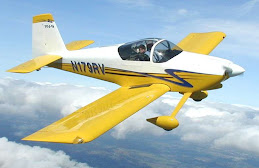Pop-riveted right elevator bottom skin to spar. Riveted on right elevator counterbalance skin. Riveted both end ribs to top and bottom skin except last three rivets on each run. Drilled out and replaced faulty rivets in rudder skins. Assembled rudder skins on rudder skeleton. Installed R710 rudder brace. Riveted rudder skeleton to skin.
I borrowed my pal Bryan Sheane's 4" thin-nose-no-hole ("4TNNH"?) yoke and his longeron yoke for the jobs I had to do today. It is becoming clear that these tools are essential, whether you have a hand squeezer and (or) an air squeezer. So, I ordered my own from Avery's. They should be here within 2 weeks by Express parcel post.
The manual and lots of builders sites will give you the impression that pop-rivets are the only solution for at least some of these holes. However, the longeron yoke made short work of them all and every rivet is perfect - Don't hesitate, get yourself one of each of these great tools!
 After 187 hours and 25 minutes working on the project, I finally get to drive my first permanent rivet. I guess my approach of prepping everything and then priming everything before finally assembling
After 187 hours and 25 minutes working on the project, I finally get to drive my first permanent rivet. I guess my approach of prepping everything and then priming everything before finally assembling 
